![]()
Croeso i Rhondda
Welcome to the Rhondda
![]()
Midi Playing:
 Although
Newport, Wales's third-largest conurbation, doesn't have Cardiff's
cosmopolitan confidence or Swansea's bright-and-breezy beside-the-sea
charm, pockets of considerable interest are contained within that\par
bland coat.
Although
Newport, Wales's third-largest conurbation, doesn't have Cardiff's
cosmopolitan confidence or Swansea's bright-and-breezy beside-the-sea
charm, pockets of considerable interest are contained within that\par
bland coat.
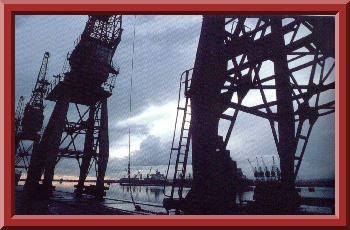
Newport Docks.
This first becomes apparent as the train crosses the River Usk, and a ruined castle comes into view on the riverbank. This medieval shell was built in the 14th and 15th centuries to replace an earlier hilltop motte and bailey fortification. Newport's history began long before medieval times. St\par Woolo's Cathedral, on the top of Stow Hill (also the location of Newport's original castle), occupies the site of a 5th or early 6th-century religious settlement founded by Gwynllyw, lord of Gwynllwg.
Newport really came of age in the 19th\par century, because of its growth as an iron and coal exporting port serving the bearby industrial valleys. The Victorian boom-years are reflected in the architecture. A particularly fetching piece of Victoriana is the covered market, with its iron and glass barrel-vaulted roof, which has been restored to its original splendour.
![]()
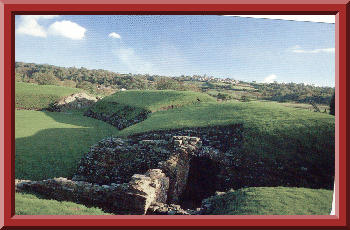
Caerleon fortress.
 Near
to Newport is the Roman fortress of Caerleon, alias Isca,
it was, along withthe much more famous centres of Chester and York, one
of only three Roman fortress towns in Britain, built to accommodate the
elite legionary troops. But Caerleon's celebrity is on the up and up. This
is partly due to the opening of an impressive excavated bath-house complex,
the Roman equivalent of a modern sports and leisure centre.
Near
to Newport is the Roman fortress of Caerleon, alias Isca,
it was, along withthe much more famous centres of Chester and York, one
of only three Roman fortress towns in Britain, built to accommodate the
elite legionary troops. But Caerleon's celebrity is on the up and up. This
is partly due to the opening of an impressive excavated bath-house complex,
the Roman equivalent of a modern sports and leisure centre.
Caerleon's lavish Fortress Baths were built in AD 75. They were part of a huge 50-acre (20-hectare) camp that contained barracks, a headquarters, hospital, palace and amphitheatre, all laid out on an orderly grid-iron ground plan. It's still easy to appreciate the Romans' enthusiasm for the place. Caerleon is a neat and tidy little town in a favoured location. Standing among green fields above the looping River Usk, is must have been an ideal place to set up camp well away from the heathen wastes of an upland Wales polulated by uncooperative natives.
![]()
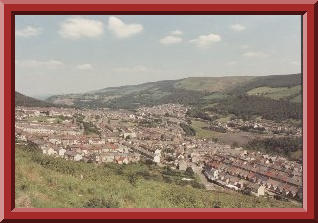
Mountain Ash.
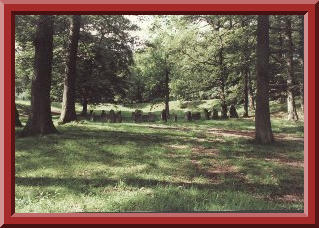
Duffryn Woods, Mountain Ash.
![]()

Pontsticill Reservoir.
Supplying the water for the people of\par Merthyr
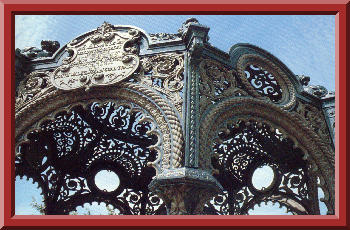
Memorial, Merthyr Tydfil.
 The
"capital" of the Valleys is Merthyr Tydfil, named after St Tydfil
the Martyr, daughter of the Welsh chieftain Brychan killed at the hands
of marauders in the year 480. Merthyr is where an essential part of the
Industrial Revolution started in the second half of the 18th century. It
is here that iron ore and coal were first combined on a commercial scale
to produce iron and then steel.
The
"capital" of the Valleys is Merthyr Tydfil, named after St Tydfil
the Martyr, daughter of the Welsh chieftain Brychan killed at the hands
of marauders in the year 480. Merthyr is where an essential part of the
Industrial Revolution started in the second half of the 18th century. It
is here that iron ore and coal were first combined on a commercial scale
to produce iron and then steel.
The cannon balls that sank Napoleon's fleets at the Nile in 1799 and Trafalgar in 1805 were made in Merthyr. So, too, were the railway lines that in the long era of peace after Waterloo were laid around much of the world - in France, Germany and the US as well as throughout the growing Empire.
![]()
Aberfan.
Etched in the memory, on the morning of 21 October 1966, just after school had opened on a desperately wet day, that the tip moved and slid down on the little village school, killing 116 children and 28 adults.
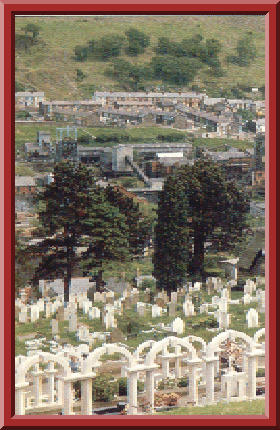
The sad rows of headstones in the cemetery\par can be seen for miles across the valley.
![]()

Monmouth Bridge.
Monmouth can claim several places in history. Geoffrey of Monmouth, who might have been a monk of the Benedictine Priory in the town, produced a history of England, the History of the Kings of Britain, which contained more fantasy than fact but which, like Shakespeare's more popular history plays, became accepted by many as the unvarnished truth.

Monmouth's twin heroes: Henry V. and Henry\par Rolls.
A more recent celebrity was Charles Rolls, the co-founder of Rolls-Royce, who until his death in 1910 in a flying accident lived in The Hendre, a handsome manor house near the town.
Monmouth's most famous son, however, is without doubt Henry V (Good King Hal), who won the Battle of Agincourt - Monmouth's main square is called Agincourt Square. He was born in 1387 in Monmouth castle, which was largely destroyed in the Civil War a few walls are all that remain. The town museum has plenty of information on Henry, Rolls and Geoffrey - but its star exhibits concern quite a different character, Admiral Lord Nelson.
Nelson came to Monmouth only twice, but such was his status - equivalent to that of some sort of TV superstar today - that these visits had a profound effect on local sensibilities.
The town's most outstanding sight is the 13th-century Monnow Bridge, Britain's only surviving fortified bridge and still in regular use today ( its low headroom constitutes a continuing menace to double-decker buses).
![]()

Raglan Castle.
Raglan Castle, built in the fifteenth century --unusually late-- is a sophisticated structure, designed to resist cannon balls rather than arrows. The Great Tower is a castle within a castle, having its own moat and planned as a final place of refuge. In fact the castle developed into a comfortable residence, and the most serious action there was in 1646 when it was captured by Parliamentary forces and systematically ruined.
There is still a great deal to see and a visit is highly recommended.
![]()
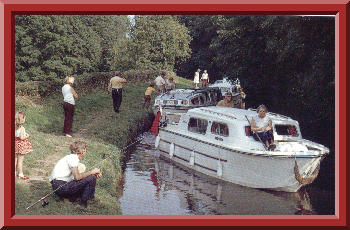
Brecon and Monmouthshire Canal.
This waterway is now navigable for the whole distance in a setting of the utmost rural charm, with the possibility of fishing and pleasant towpath walks. Sooner or later, though, you come back to geology, as you always must in South Wales. On these southern fringes of the park you are in the limestone belt with its wooded ravines, its graceful lime-loving ash trees, pale escarpments and above all its caves.
![]()

Brecon Beacons Mountain Railway.
The Brecon Beacons Mountain Railway runs from Pant up into the park and to Pontsticill Lake, the railway, 2 miles long, is the brainchild of Tony Hills and his wife Jenny; he as tall as she is tiny. At the Pant end, which might loosely be called the terminus, the station shop caters for the tourist. Elsewhere in the town, the Guest Memorial Library was built in 1863 at the instigation of Lady Charlotte Guest (who had translated The Mabinogion, the great Welsh work of the Middle Ages, into English), as a memorial to her husband Sir John Josiah Guest (now enshrine in the company Guest, Keen and Nettlefold) who had died a decade earlier. It was designed by Sir Charles Barry but is now a recreational centre.
![]()

Cottage in Abergavenny.
 Abergavenny,
not actually in the Brecon park, but like Merthyr Tydfil, 17 miles (27 km)
to the west, a gateway. A smart shopping centre complements the twice-weekly
market (Tuesday and Friday) when farmers' wives still bring home-made butter,
free-range eggs and fresh cut flowers as their perks to sell in the market.
Abergavenny used to be noted for its Welsh white flannel and exported large
amounts to India. Rudolf Hess spent the war here, imprisoned at Maindiff
Court, once the home of Crawshay (Cosher) Bailey, the Victorian ironmaster
Abergavenny,
not actually in the Brecon park, but like Merthyr Tydfil, 17 miles (27 km)
to the west, a gateway. A smart shopping centre complements the twice-weekly
market (Tuesday and Friday) when farmers' wives still bring home-made butter,
free-range eggs and fresh cut flowers as their perks to sell in the market.
Abergavenny used to be noted for its Welsh white flannel and exported large
amounts to India. Rudolf Hess spent the war here, imprisoned at Maindiff
Court, once the home of Crawshay (Cosher) Bailey, the Victorian ironmaster
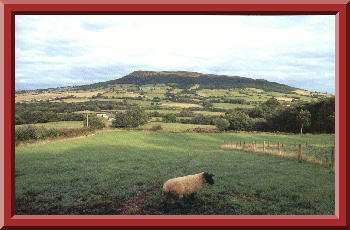
Sugar Loaf\par Mountain.
The town is in an hollow, surrounded by hills, the Sugar Loaf (1.955 ft/596 metres) Skirrid Fach and Skirrid Fawr, and the Blorenge, or Blue Ridge, on the summit of which is the memorial to Foxhunter, legendary showjumper of the 1950s, whose rider, Sir Harry Llwellyn, lived in the Usk valley.
![]()

Llanthony Priory.
Situated in the Vale of Ewyas, an Augustinian monastery founded in the 12th century. Llanthony priory - the name is an abbreviation of Llandewi nant Honddu, the church of St David on the Honddu brook - now houses a hotel and restaurant in what used to be the Prior's Lodge and south-west tower.
The row of 14-th century pointed arches seen by moonlight is a sight not soon forgotten.
![]()
Four miles (6 km) up the valley is Llanthony Abbey at Capel-y-ffin where Father Ignatius, an Anglican clergyman who claimed to have seen a vision of the Virgin Mary in a nearby field, founded a monastery.
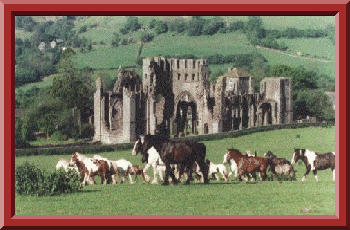
Llanthony Abbey.
It ceased to exist soon after his death in 1908 but was later the setting for a craft community led by the Catholic sculptor and graphic designer Eric Gill.
![]()
"I sincerely hope that you have enjoyed your visit and that one day you will yourself be able to visit this beautiful country and to meet the wonderful people of Wales."
Malcolm.
![]()
View
My Guestbook
Sign
My Guestbook
![]()
Malcolm
mal@jupiter98.freeserve.co.uk
Date Last Modified: 15/10/05
